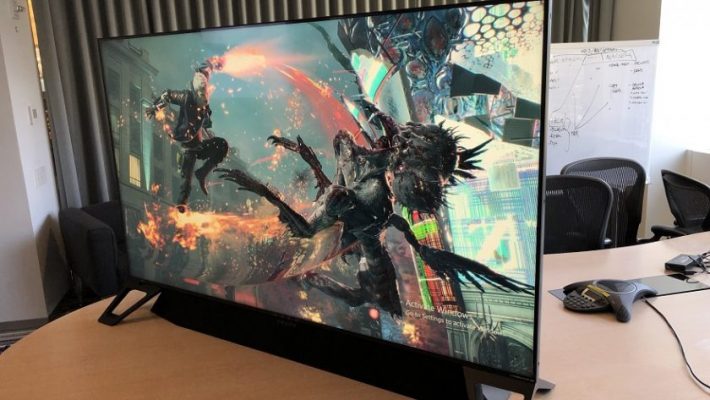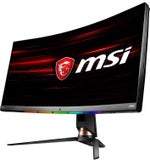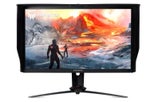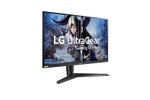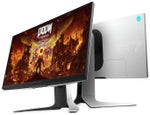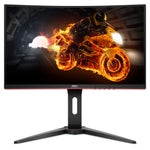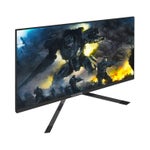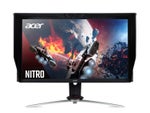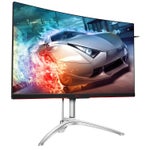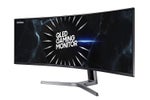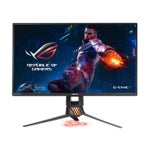Gaming at a desk has always had a couple of big advantages over gaming on a couch. Two examples – High refresh rates and G-Sync. How good is HP Omen X 65 UHD 4K gaming monitor? What are the HP Omen X Emperium 65 Specs? Now, the living room has caught up. The 65-inch Omen X Emperium might not call itself a television, but with its massive screen real estate and wide stance, this thing is made for the living room. How much is HP Omen x 65 price? It challenges the very definition of a gaming monitor, as does its $5,000 price tag. So, do the unique gaming features make for the ultimate PC gaming experience, or are you better off with a standard television?
What are the HP Omen X Emperium 65 specs?
Find below HP Omen X Emperium 65 specs in 2020 –
| Display size (diagonal) | 65″ |
|---|---|
| Aspect ratio | 16:9 |
| Native resolution | 4K UHD (3840 x 2160 @ 144 Hz)1 2 |
| Pixel pitch | 0.372 mm |
| Brightness | 750 cd/m² |
| Contrast ratio | 4000:1 static |
| Response time (typical) | 14 ms gray to gray |
| Display features | Anti-glare Language selection LED backlights On-screen controls Plug and Play User controls NVIDIA G-SYNC™ IR sensor |
| Display Input Type | 1 DisplayPort™ 1.4 (with HDCP support) 3 HDMI 2.0 (with HDCP support) |
| Ports | 1 audio-out 1 Ethernet (10/100/1000M GbE) 2 USB 3.0 (fast charging, power delivery up to 4.5 W) 1 SPDIF |
| Weight | 71.4 lb7 |
| Minimum dimensions (W x D x H) | 57.01 x 3.3 x 32.76 in8 |
| Product dimensions with stand (W x D x H) | 57.01 x 13.4 x 36.78 in |
| Power consumption | 700 W (maximum), 420 W (typical), 0.5 W (standby) |
| Operating temperature range | 41 to 95°F |
| Operating humidity range | 20 to 80% non-condensing |
| Environmental | Arsenic-free display glass Low halogen Mercury-free display backlights |
| What’s in the box | AC power cord DisplayPort™ cable Documentation HDMI cable Remote controller Sound bar kit |
| Warranty | Limited 1 year warranty. Certain restrictions and exclusions apply. |
Buying guide – best gaming monitor
Below I go over the three essential things you should consider before buying the best gaming monitor including screen size, resolution, and aspect ratio. I’ve also briefly explained a few of the more technical aspects of computer display such as panel types, refresh rate, and the variable refresh rate technologies available today. Specially on HP Omen X 65 UHD 4K gaming monitor.
Screen size: “How big?” Will probably be the first thing you’ll ask yourself when you go about buying a gaming monitor, and the answer really comes down to your unique situation. Are you in a tiny dorm with barely any room or are you looking to get a 43-inch gaming monitor to replace your TV – HP Omen X Emperium 65 specs?
How you answer that question will ultimately determine the display size you need. But if you’re looking for some basic guidelines on screen sizes, 24- to 27-inch gaming monitors will satisfy most gamers. Those looking for a more immersive experience might be interested in a 32-inch or larger screen. As with most things, gaming monitors will usually become more expensive as you go up in size, so think with your budget as much as your ambition.
Aspect ratio: The aspect ratio of your monitor is closely related to its size because it determines which form factor your display will have (HP Omen X Emperium 65 specs). The majority of monitors fall into the widescreen category with their 16:9 aspect ratio. Ultrawide displays have been rising in popularity recently and these screens often feature the 21:9 aspect ratio you would typically see at the movie theater. If you can believe it modern gaming monitors have only been getting even wider and there’s a growing crop of 32:9 displays as well.
Screen resolution: This determines how sharp your gaming monitor will be and, for the most part, there are three choices: Full HD (1,920 x 1,080), Quad HD (2,560 x 1,440), and Ultra HD or 4K (3,840 x 2,160). Like screen size, as the numbers go up so does the price, plus they’ll require a higher-end graphics card if you hope to maintain a high frame rate (HP Omen X Emperium 65 specs).Think with your budget as much as your ambition
Panel type: Although most monitors might look the same on the surface, there are a few different panel types that offer specific benefits and shortcomings. Twisted Nematic (TN) panels are the most basic and common panel you’ll come across as they deliver the fastest response times of 1ms often at the cost of duller colors, grayer black levels, and poor viewing angles.
In-Plane Switching (IPS) is the next most prevalent type of display and it’s basically the opposite of a TN panel. Rather than focusing on speed, IPS panels are known for rendering excellent colors and contrast while offering wider viewing angles in exchange for slightly slower response time, usually hovering around 3-5ms. This is another HP Omen X Emperium 65 specs.
Lastly, Vertical Alignment (VA) panels are becoming increasingly common and they essentially split the difference between TN and IPS panels. They offer great image quality with decently quick response times. VA panels aren’t perfect, though, as sometimes fast-moving objects will give off ghosting effects due to the slower response time.
If you want a responsive gaming monitor, it’s best to pick one with a fast response time, which is a measure of how quickly a pixel can change from the brightest to the darkest (white to black) color.
Response time: Competitive shooters and MoBAs demand the quickest response times, so it’s best to play these types of games on monitors that offer a 1ms response time. Playing Indie games and most single-player experiences shouldn’t be a problem on a display with a response time between 3-5ms – and it’s pretty much impossible to find a gaming monitor that is slower than this.
Refresh rate: This is another important measure of how responsive a gaming monitor is, and it defines how often your screen can display a completely new image — so it essentially dictates your frame rate. 60Hz is the standard refresh rate for silky smooth PC gaming, but there’s a long list of gaming monitors that feature even higher refresh rates of 120Hz, 144Hz, and, so far, up to 240Hz (HP Omen X Emperium 65 specs).
Basically, the higher the refresh rates the more times the image on your screen will update every second, resulting in a smoother gameplay experience. Beyond the visual appeal of high refresh rate displays, they can be useful for gamers who need to keep up with the rapid movements competitive games demand. Generally, you’ll be at an advantage if you see your opponents and react before they do.
G-Sync vs FreeSync: Variable refresh rate (VRR) technology is a fairly recent invention and it ensures you have a consistently smooth and responsive gaming experience. Currently, there are two flavors of VRR, Nvidia G-Sync and AMD FreeSync, and they’ll require a prerequisite that you own a compatible graphics card from the corresponding brand. Nvidia GeForce cards do allow you to enable VRR on any FreeSync monitor, but your results will vary.
At the most basic level, VRR syncs your monitor’s refresh rate with the number of frames your GPU outputs. This prevents screen tearing caused by the graphics card feeding your display multiple frames while it’s is in the middle of refreshing its picture. If your graphics card is running your game at 60 fps, you’ll see your monitor refresh at exactly 60Hz with wonderfully smooth gameplay (HP Omen X Emperium 65 specs).
My only other piece of advice when buying a gaming monitor is to make sure your video card can handle the resolution and refresh rate of the display you’re considering. It would be a waste of money to buy a 4K gaming monitor when your GPU can only handle 1080p gaming.
Is it a gamer’s television?
The HP Omen X 65 UHD 4K gaming monitor is a TV. No, it doesn’t have a tuner, but it is meant to sit in a living room in place of a television. For all intents and purposes, it’s a 65-inch television.
Which is why, I assume, HP didn’t do anything crazy with its design. Outside of the name, you might not even know it wasn’t from LG or Samsung unless you notice the Omen logo at the base of the screen. The set has slim bezels, industrial metal mounts, and even comes with a fairly nondescript black soundbar. It’s impressive for HP’s first foray into living room-sized screens.
From the front, at least.
Turn it around and the Emperium has more explicitly gaming-oriented chrome, including an Omen logo and some lights. Because most people will want their TV up against a wall, most of that will go unseen. You will notice, however, the LED strip across the back cabinet that adds splash of red glow on your wall. It’s a subtle touch that provides a nice distinction from competitors. The design is completed by a slick, black soundbar that comes bundled in the box.
That’s not to say the Emperium is a dainty, ultra-thin display. Befitting of the name, the Emperium is hefty. It’s heavy (as is the box) and super-sturdy.
You’ve got access to two USB-A ports, two HDMI ports, an ethernet jack, and DisplayPort (HP Omen X Emperium 65 specs).
It also uses legs at each end of the display instead of a single stand in the middle. That makes it feel solid, but you’ll need a huge entertainment stand to get it up off the ground. Upcoming large-screen gaming monitors like the Asus ROG Swift PG65 or the Alienware 55-inch OLED gaming monitor include more traditional stands. The Emperium does have VESA mount.
Yup, you can mount this massive screen up on a wall if your heart so desires.
The subdued look is important, though. The Omen X Emperium may have gaming chops at the forefront of its marketing, but if you’re putting this in your living room, you don’t want it to stand out while watching a movie using the included Nvidia Shield interface. Nvidia previously sold the set top box as a separate unit, but it’s now built into the television in the same way Roku TV might be. That gives the Emperium important smart TV capabilities (HP Omen X Emperium 65 specs).
The port selection is PC-ready
The Omen X Emperium features a wide selection of ports, including the ones you’d expect and some interesting PC-specific options. On the right side, you’ve got access to two USB-A ports, while on the left you have your two HDMI ports, an ethernet jack, and DisplayPort. The DisplayPort is what allows for the highest refresh rates – up to 120Hz (overclockable to 144Hz).
The power switch, as well as the power plug, are both located on the back, in a rather hard-to-reach spot. It can be difficult to set the display up. Once you do, though, you can forget about it – this is basically a television, after all.
Can you control with limited remote?
The Emperium’s remote and controls could be better. A single joystick is located on the bottom right side of the back of the unit, giving you access to different color modes and settings.
We must talk about the remote controller, though. It has some issues. It’s the same remote you’ll find packaged with an Nvidia Shield TV set top box, and for that, it works fine. However, its features are limited for a remote that’s supposed to control the entire display. It has just a single navigation wheel, a back button, a home button, and a Google Assistant button.
It doesn’t seem sure if it wants to be a television or a gaming monitor.
The center of the navigation acts as your power button when turning it on, but there’s no dedicated button to turn it off. If you’re using the Shield TV, you’ll have to navigate up to the top and over to Settings, where you can then click on Sleep. The screen will, of course, go to sleep on its own, but a dedicated button on the remote would have been nice.
It’s the same problem when trying to access things like switching inputs. Once you’re in Shield TV mode, the only way to switch over to your PC is to head back up to settings and select On Screen Display, which brings up the standard screen settings. It’s something that could have been avoided by voice command, but voice commands don’t work for most TV settings.
Then there’s the volume slider. Instead of a pair of buttons or a rocker, the Shield TV remote uses a touch-sensitive slider across the bottom half of the front of the remote. It feels slow at first, then jumps between volume levels way too quickly. You can easily find yourself turning the volume up from 25 to 75 without intending to, waking up your entire neighborhood as a result.
As mentioned, the soundbar is included in the box. It’s a nice addition given the price of the package, but it’s nothing special. Bass doesn’t have a strong presence, and it’s delivered through a single 3.5mm jack. If you’re spending this much on a television, chances are you’ll want some surround sound to complement the visuals.
The controls are where the Emperium’s seams show. Unfortunately, using this as the central hub of your entertainment system just doesn’t feel like a cohesive or fluid experience. Its not sure if it wants to be a television or a gaming monitor.
How much is HP Omen X 65 price?
At $5,000, it’s no surprise that the gaming experience on the Emperium is excellent. It’s a 4K, 3,840 x 2,160 resolution screen, complete with support for a 120Hz refresh rate (144Hz if you overclock, and why wouldn’t you?), G-Sync, and HDR1000. These are all the specifications you want to see in a gaming monitor — and some are a first for aliving room screen.
G-Sync is perhaps the most notable. Nvidia keeps a tight wrap on its patented adaptive sync tech — and for good reason. It’s the best in the business. Seeing a smooth, tear-free experience on the big screen is impressive. So long as you stick to the DisplayPort input, a fast-paced game like Battlefield V or Fortnite looks better than ever. It feels lag-free and smooth in a way that only a true gaming monitor can offer.
But things in the TV world are changing. Samsung will soon offer HDMI 2.1, which brings variable refresh rate to standard televisions. FreeSync, the popular alternative to G-Sync, is now also being offered on these platforms for AMD systems.
The results we saw from our colorimeter were equally impressive. We measured the Emperium with our standard monitor testing and saw a record-high contrast ratio and brightness. 592 nits is enough to overpower any reflections, even in a well-lit room. Meanwhile, we saw impressive black levels across the board, which makes both games and movies all the more immersive. You won’t be editing photos on it, but the Emperium even has decent color gamut and color accuracy.
It can’t be only judged as a monitor though. Sitting straight-on, the contrast looks great and the colors are vivid. When you move off axis, things take a turn for the worse. It’s a problem with nearly all LCD screens, but this one is even more noticeable than normal. Bright, vivid colors look washed out and blacks lose their sense of depth. If you’ll be playing games solo, it’s not a problem. But if you’re playing local multiplayer or watching movies with a large group, your seat in the room will give a less than positive viewing experience.
We also noticed vertical banding, as well as vignetting and splotchy areas along the edges. None of it is atrocious, but the processing and the quality of backlighting can’t compete with the best TVs from Samsung or LG. That’s a problem because the Emperium is expensive. You could almost buy two top-tier LG OLED televisions for the same price.
So many ways to play games – HP Omen X 65 UHD 4K gaming monitor
Though it’s meant to be used with a PC, the Emperium is a capable smart TV. Nvidia’s Shield TV is powered by Android TV, so it comes with a pleasant interface and direct tie-ins to YouTube, Netflix, and Google Play Movies. It even has Chromecast built-in, meaning you cast the screen of your laptop or phone to it.
As noted on the remote, it also has support for Google Assistant, tied right into the remote. It’s one of our favorite voice assistants, and having it in the living room is always an added convenience.
Unless you own two PCs or like carrying your desktop from room to room, it just doesn’t make much sense.
Specific to the Shield TV, as well, is Nvidia’s game-streaming service, GeForce Now. It’s a bit of an odd thing to have on a television meant for connecting to a powerful PC, but hey, it does put the service in the hands of more people. You could can also use GameStream, which allows you to stream a game from another PC in your network to this display, without having to lug your PC around and connect it directly.
It makes a lot of sense as a feature on for the Nvidia Shield TV, but again, doesn’t make much sense on the Emperium. That’s because both GeForce Now and GameStream fail to make full use of the display’s high refresh rate and solid image quality. Streaming games to the Emperium is convenient, but if you’re going to do that, you may as well use a ‘normal’ television.
That shines a spotlight on the real issue with the Emperium — and the very idea of the living room PC. Most people use their gaming rigs for things other than gaming once and awhile. Writing a term paper, editing an Excel document, or even browsing the web just aren’t activities suited for the living room. Unless you own two PCs or are fine carrying your desktop from room to room, it just doesn’t make a lot of sense. But for those who swear by letting their PC be the center of their living room, features like GeForce Now or game-stream are nice additions.
How good is HP Omen X 65 UHD 4K gaming monitor?
The Omen X Emperium is the first of its kind. It’s a trailblazer for sure, but that doesn’t mean it’s quite ready for prime time. As of now, for a very specific person, the Omen X Emperium might make some sense. If you plan to leave your powerful gaming rig in your living room and use it pretty much exclusively for games, the Omen X Emperium is one of the best gaming experiences you can have. So long as you’ve got a spare $5,000.
For most people, though, television-sized screens and gaming PCs still don’t go together. Things like Windows 10, mice, and keyboards are all office tools, meant for a desk. Even just figuring out how HP or Nvidia might imagine someone use the Emperium required some imagination. Until there are more obvious advantages over a traditional television, it’s a hard option to recommend for the average gamer. HP Omen X 65 UHD 4K gaming monitor is ambitious gamer.
Is there a better alternative?
There are plenty of fantastic gaming monitor out there, all of which have 4K, G-Sync, and 144Hz. Meanwhile, there are extra-large gaming monitors, as large as 49 inches, that are still designed for the desk. The best is the Samsung CHG90.
If you’re looking to fill your living room, some of the best television options for gaming include the Samsung QLEDs, which will soon support variable refresh rate and AMD’s FreeSync adaptive sync. It’s bound to give you significantly better image quality at a lower price.
There are also a couple more displays on their way more in the vein of the Emperium. Asus has a ROG-branded 65-inch G-Sync gaming monitor, and Alienware has its 55-inch OLED option.
Should you buy it?
No, probably not. A high-end television will give you better picture quality, and some even provide variable refresh rate for smoother gameplay.
HP Omen X 65 UHD 4K gaming monitor comparison
| OMEN X Emperium 65 | OMEN by HP Gaming Desktop | OMEN by HP 25 Display | |
| Features | 4K UHD Gaming Display | 8th Gen Intel Core i7-8700 | 144Hz Refresh Rate |
| . | Rapid Refresh Rate 144Hz | GeForce RTX 2080 8GB | 1ms Response Time |
| . | NVIDIA G-SYNC HDR-1000 | 16GB DDR4 | AMD FreeSync(TM) |
| . | 95% DCI-P3 Color Gamut | 2TB Hard Drive + 256GB SSD | Mercury-free LED Backlighting |
| . | 1,000 Nits Peak Luminance | VR Ready 2080 PC | 1.2, 2 HDMI 1.4, 2 USB 3.0 |
Compare with similar items
| OMEN X by HP Emperium 65 inch 4K Big Format Gaming Display | Asus ROG Strix XG438Q 43″ Large Gaming Monitor with 4K 120Hz FreeSync 2 HDR Display | Asus ROG Swift PG27UQ 27″ Gaming Monitor 4K UHD | |
|---|---|---|---|
| Customer Rating | 2 out of 5 stars (5) | 4 out of 5 stars (22) | 4 out of 5 stars (129) |
| Price | $4,461.39$4,46139 | $1,048.98$1,04898 | $1,299.99$1,29999 |
| Display Resolution Max | 2560 x 1440 pixels | 3840 x 2160 pixels | 3840×2160 pixels |
| Display Size | 27 in | 43 in | 27 in |
| Display Type | — | LCD | LED-Lit |
| Item Dimensions | 2.2 x 24.2 x 14.4 in | 38.37 x 24.85 x 9.54 in | 25 x 3.7 x 15 in |
| Item Weight | 7.58 lbs | 45 lbs | 20.3 lbs |
| Mounting Type | Wall Mount | — | Wall Mount |
| Refresh Rate | 60 | 120 hertz | 144 hertz |
| Size | — | — | 27″ |
What are the other Best Gaming Monitors of 2020
Whether you’re looking for a 4K HDR screen to play Call of Duty: Modern Warfare in all its glory or a 240Hz display to help you win in Apex Legends, you’ll find the right gaming monitor for you here.
- MSI Optix MPG341CQR
- Acer Predator XB273K
- LG 27GL850 UltraGear
- Alienware 27 Gaming Monitor
- AOC C27G1 Curved Gaming Monitor
- Viotek GFT27D
- Acer Nitro XV273K
- AOC AG322QC4 Curved Gaming Monitor
- Samsung CRG90 Curved Gaming Monitor
- Asus ROG Swift PG27UQ
1. MSI Optix MPG341CQR – Best Gaming Monitor
Screen size: 34″ ● Aspect ratio: 21:9 ● Resolution: 3,440 x 1,440 ● Panel type: VA FreeSync 2 ● HDR Compatibility: HDR10 ● Brightness: 400cd/m2 ● Refresh rate: 144Hz ● Response time: 4ms ● Viewing angle: 178(H)/178(V) ● Contrast ratio: 3,000:1 ● Color support: 8-bit ● Inputs: 2 x HDMI 2.0, 1 x DisplayPort 1.2, 1 x USB Type-C ● Weight: 21.38 pounds ● Size: 31.9″ x 22.2″ x 12.8″
While consoles have caught up with 4K HDR gaming one thing PC gaming simply does better is support for ultrawide gaming monitors. We think a 21:9 aspect ratio—or wider—is the best type of screen for PC gaming and the MSI Optix MPG341CQR is the clear winner here. This 34-inch display offers up an enrapturing 3,440 x 1,440 resolution that wraps around you. Better yet you also get a 144Hz experience and the response time of this panel is 4ms, making it a tiny bit faster than your average IPS display.
It also supports HDR, albeit with only a 400-nit peak brightness and 8-bit color, so it’s not the absolute best high-dynamic range experience you’ll find out there. But for $800 this ultrawide gaming monitor offers a lot with one of the best-looking displays around plus plenty of ports to connect a variety of devices including a USB Type-C for your gaming laptop and gaming phones. It is more popular to gamer than HP Omen X 65 UHD 4K gaming monitor due to its price and feature.
2. Acer Predator XB273K – Best 4K Gaming Monitor
Screen size: 27″ ● Aspect ratio: 16:9 ● Resolution: 3,840 x 2,160 ● Panel type: IPS G-Sync ● Brightness: 400cd/m2 ● Refresh rate: 144Hz ● Response time: 4ms ● Viewing angle: 178(H)/178(V) ● Contrast ratio: 1,000:1 ● Color support: 90% DCI-P3, 87% ARGB, 100% sRGB ● Inputs: 1 x HDMI 2.0, 1 x DisplayPort 1.4 x ● Weight: 15.85 pounds ● Size: 24.76″ x 21.3 x 12.09″
The Acer Predator XB273K is essentially the semi-HDR version of its older sibling, the Acer Predator X27. While it doesn’t hit a 1,000-nit peak brightness or feature Quantum Dot technology, it also doesn’t cost $2,000. Nope, instead, the Acer Predator XB273K is a refined 27-inch, 4K gaming monitor designed to give you the sharpest 144Hz gaming experience for a little more than a grand.
This monitor still meets the HDR400 specification (up to a 400-nit peak brightness), so it’s still a bit brighter than your typical gaming monitor. Colors are also on-point. The Acer Predator XB273K can tap into 100% of the sRGB and 90% of the DCI-P3 color spectrum. Just know that to get the best colors out of this display, you’ll have to select 98Hz as your maximum refresh rate due to the bandwidth limitations of the DisplayPort 1.4 standard. Well known to the market rather than HP Omen X 65 UHD 4K gaming monitor.
3. LG 27GL850 UltraGear – Best 1440p Gaming Monitor
Screen size: 27″ ● Aspect ratio: 16:9 ● Resolution: 2,560 x 1,440 ● Panel type: Nano IPS FreeSync, G-Sync Compatible ● Brightness: 350cd/m2 ● Refresh rate: 144Hz ● Response time: 1ms ● Viewing angle: 178(H)/178(V) ● Contrast ratio: 800:1 ● Color support: 1.07B ● Inputs: 2 x HDMI 2.0, 1 x DisplayPort 1.4 ● Weight: 13.45 pounds ● Size: 24.2″ x 22.6″ x 10.8″
The LG 27GL850 UltraGear is one of the best all-around gaming monitors available right now. It’s gorgeous Nano IPS panel resolves a 2,560 x 1,440 picture that’s perfectly sharp for its 27-inch screen size. What’s more, the image is bright at 350-nits and richly colored thanks to its support for 10-bit color, which when put together makes this screen HDR10 ready.
Better yet the LG 27GL850 UltraGear delivers a 144Hz refresh rate and 1ms response time, so it overcomes the usual pitfalls of an IPS display. Lastly, this gaming monitor supports both FreeSync and G-Sync, so you’ll get a smooth tear-free experience with any gaming PC or gaming laptop.
4. Alienware 27 Gaming Monitor – Best 1080p Gaming Monitor
Screen size: 27″ ● Aspect ratio: 16:9 ● Resolution: 1,920 x 1,080 ● Panel type: Fast IPS FreeSync, G-Sync Compatible ● Brightness: 350cd/m2 ● Refresh rate: 240Hz ● Response time: 1ms ● Viewing angle: 178(H)/178(V) ● Contrast ratio: 1,000:1 ● Color support: 16.7M ● Inputs: 2 x HDMI 2.0, 1 x DisplayPort 1.2 ● Weight: 28.24 pounds ● Size: 24.12″ x 22 x 17.5″
It might seem strange that people are still buying 1080p gaming monitors when 4K gaming is all the rage, but this old-school resolution still has something to offer. The best Full HD gaming monitors these days offer are still useful for attaining ridiculously high frame rates and they’re just starting to support HDR picture modes.
The Alienware 27 Gaming Monitor is a perfect example of what you can get from a modern day 1080p gaming monitor. It features a “Fast IPS” panel that achieves a quick 1ms response time while delivering the wide viewing angles and rich color accuracy you’d expect from this type of display technology. To sweeten this deal even more, the Alienware 27 Gaming Monitor supports both FreeSync and G-Sync. Top choice to most gamers than HP Omen X 65 UHD 4K gaming monitor.
5. AOC C27G1 Curved Gaming Monitor – Best Budget Gaming Monitor
Screen size: 27″ 1,800R ● Aspect ratio: 16:9 ● Resolution: 1,920 x 1,080 ● Panel type: VA FreeSync ● Brightness: 250cd/m2 ● Refresh rate: 144Hz ● Response time: 1ms ● Viewing angle: 178(H)/178(V) ● Contrast ratio: 3,000:1 ● Color support: 74% ARGB, 97% sRGB ● Inputs: 2 x HDMI 1.4, 1 x DisplayPort 1.2, 1 x VGA ● Weight: 13.67 pounds ● Size: 24.09″ x 15.94″ x 9.65″
AOC has been building solid budget-range monitors for years and the AOC C27G1 Curved Gaming Monitor is one of its best offerings yet. This monitor’s 27-inch curved panel serves up a 1,920 x 1,080 resolution with a 144Hz refresh rate, and AMD FreeSync to eliminate screen tearing. As it uses an excellent Vertical Alignment (VA) panel you can expect a balanced experience with great colors and quick response time.
The only thing I find a little lacking is it’s a bit dimmer than other monitors—brightness maxes out at only 250-nits. But its shortcomings are easy to overlook thanks to this monitor’s sub $300 sticker price and pretty great specs. The AOC C27G1 isn’t going to blow your mind, but it’s an affordable gaming monitor that all PC gamers should consider.
6. Viotek GFT27D – Best Budget 1440p Gaming Monitor
Screen size: 27″ ● Aspect ratio: 16:9 ● Resolution: 2,560 x 1,440 ● Panel type: TN FreeSync ● Brightness: 220cd/m2 ● Refresh rate: 144Hz ● Response time: 3ms ● Viewing angle: 170(H)/160(V) ● Contrast ratio: 1,000:1 ● Color support: 115% sRGB ● Inputs: 2 x HDMI 1.4, 1 x HDMI 2.0, 1 x DisplayPort 1.2 ● Weight: 8.6 pounds ● Size: 24.3″ x 17.5″ x 7.9″
The Viotek GFT27DB is the perfect cheap monitor to go with if you want a 1440p that’ll stick to your budget. Priced at just $300, this QHD monitor also delivers a 144Hz refresh rate and 1ms response time (with Overdrive) thanks to its TN panel. Colors and contrast on this display are surprisingly not half bad despite its TN panel.
It also supports FreeSync for the Xbox One S and Xbox One X. as well as AMD-powered gaming PCs and gaming laptops. What’s more, I can confirm that the Viotek GFT27DB is G-Sync Compatible even if it technically isn’t on the list of supported gaming monitors.
7. Acer Nitro XV273K – Best Budget 4K Gaming Monitor
Screen size: 27″ ● Aspect ratio: 16:9 ● Resolution: 3,840 x 2,160 ● Panel type: IPS FreeSync2 HDR ● Brightness: 400cd/m2 ● Refresh rate: 144Hz ● Response time: 4ms ● Viewing angle: 178(H)/178(V) ● Contrast ratio: 1,000:1 ● Color support: 100% sRGB, 90% DCI P3 ● Inputs: 2 x HDMI 2.0, 2 x DisplayPort 1.4 ● Weight: 8.8 pounds ● Size: 21.8″ x 16.6″ x 8.0″
The Acer Nitro XV273K is one of the few 4K gaming monitors you can find for less than a grand and what a gaming monitor it is. It’s tack sharp with a 3,840 x 2,160 resolution and it meets the HDR 400 specification to produce colors that pop and inky blacks.
Just be sure to game with HDR enabled on this gaming monitor as colors and grays can look dull in standard dynamic range mode. Overall, this is a great 4K gaming monitor that costs only $900.
8. AOC AG322QC4 Curved Gaming Monitor – Best Curved Gaming Monitor
Screen size: 31.5″ 1,800R ● Aspect ratio: 16:9 ● Resolution: 2,560 x 1,440 ● Panel type: VA FreeSync 2 ● Brightness: 400cd/m2 ● Refresh rate: 144Hz ● Response time: 4ms ● Viewing angle: 178(H)/178(V) ● Contrast ratio: 3,000:1 ● Color support: 90% DCI-P3, 120% sRGB ● Inputs: 2 x HDMI 2.0, 2 x DisplayPort 1.2, 1 x VGA ● Weight: 14.64 pounds ● Size: 28.06″ x 24.99″ x 10.86″
If you want a monitor larger than 27-inches, you should start looking at curved gaming monitors. Curved gaming monitors like the 32-inch AOC AG322QC4 (read our review) are a bit easier on the eyes. Rather than having to keep looking away to the edges of a large screen, they come to you as a curved screen is designed to wrap itself around your peripheral vision.
Beyond the novelty of its curved panel, the AOC AG322QC4 is one of the best displays I’ve seen. It offers up a QHD (2,560 x 1,400) resolution, 144Hz refresh rate, and FreeSync2 HDR support. There’s also a decent selection of ports here including two DisplayPort 1.2, two HDMI 2.0, and one VGA—just know that only the HDMI ports support HDR. Not too shabby overall for a monitor that costs less than $600.
9. Samsung CRG90 Curved Gaming Monitor – Best Super Ultrawide Gaming Monitor
Samsung CRG90On AmazonSee ItScreen size: 49″ 1,800R ● Aspect ratio: 32:9 ● Resolution: 5,120 x 1,440 ● Panel type: VA FreeSync 2 ● Brightness: 600cd/m2 ● Refresh rate: 120Hz ● Response time: 4ms ● Viewing angle: 178(H)/178(V) ● Contrast ratio: 3,000:1 ● Color support: 10-bit 1.07-billion ● Inputs: 1 x HDMI 2.0, 2 x DisplayPort 1.4 ● Weight: 32.2 pounds ● Size: 47.2″ x 20.6″ x 13.7″
Samsung was the first to market with a super ultrawide curved gaming monitor and while there’ve been plenty of copycats, it still leads the market. The Samsung CRG90 is a step up over all the other 49-inch ultrawide monitor thanks to its 5,120 x 1,440 resolution, which essentially gives you two QHD ultrawide monitors packed into a single display. What’s more, this 32:9 screen offers up a 120Hz refresh rate and 600-nit peak brightness, making it uniquely qualified for HDR gaming thanks to its use of Quantum Dot technology.
It caters to productivity as much as gaming as the screen can act as two completely separate Full HD displays for two different systems. Alternatively, you could have the majority of the screen act as a 21:9 display for games and movies, while reserving the rest of the monitor for work or email.
10. Asus ROG Swift PG27UQ – Best HDR Gaming Monitor
Screen size: 27″ ● Aspect ratio: 16:9 ● Resolution: 3,840 x 2,160 ● Panel type: IPS G-Sync HDR ● Brightness: 1,000cd/m2 ● Refresh rate: 144Hz ● Response time: 4ms ● Viewing angle: 178(H)/178(V) ● Contrast ratio: 1,000:1 ● Color support: 97% DCI-P3, 99% sRGB ● Inputs: 1 x HDMI 2.0, 1 x DisplayPort 1.4 ● Weight: 20.28 pounds ● Size: 24.96″ x 17.2 x 10.55″
Ever since 4K gaming came onto the scene people have been waiting for the “next level” of performance, and the Asus ROG Swift PG27UQ is it. It was the first monitors to combine a 4K resolution, 144Hz refresh rate, G-Sync, and HDR up to an insane peak brightness of 1,000nits. Under the hood, it uses a 27-inch vertical alignment panel enhanced with quantum dots and 384 individual backlight zones. It is the Holy Grail of gaming monitors (for Nvidia GPU owners, at least).
There are some drawbacks though, namely with its $2,000 price. Secondly, it can’t do everything it promises at 144Hz because DisplayPort can’t handle the combined load of 4K resolution and 10-bit HDR color streaming at 144Hz. Expect to drop down your refresh rate to 98Hz for the true HDR experience. If you find the Asus ROG Swift PG27UQ’s starship aesthetic a little overbearing, you may want to consider the more practical-looking Acer Predator X27, which offers all the same specs, plus slightly better colors and an included display hood.
